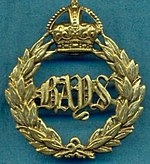2nd Dragoon Guards (Queen's Bays)
| 2nd Dragoon Guards (The Queen's Bays) | |
|---|---|

2nd Dragoon Guards (The Queen's Bays)
|
|
| Active | 1685–1959 |
| Country |
|
| Branch |
|
| Type | Cavalry |
| Role | Royal Armoured Corps |
| Size | Regiment |
| Nickname(s) | The Bays |
| Motto(s) | Pro rege et patria (Latin "for King & Country") |
| March | Quick – Rusty Buckles Slow – The Queen's Bays |
The 2nd Dragoon Guards (Queen's Bays) was a cavalry regiment of the British Army. It was first raised in 1685 by the Earl of Peterborough as the Earl of Peterborough's Regiment of Horse by merging four existing troops of horse.
Renamed several times it was designated the The Queen's Regiment of Dragoon Guards in 1746 as it evolved into a dragoon unit. (Dragoons described a force of highly mobile mounted infantry equipped with lighter,faster horses and carrying firearms) and later named the 2nd Dragoon Guards (Queen's Bays) in 1767 to reflect the custom of its soldiers riding only bay horses.
The regiment served as horse cavalry until 1937 when it was mechanised with light tanks. The regiment became part of the Royal Armoured Corps in 1939. After service in the First World War and the Second World War, the regiment amalgamated with the 1st King's Dragoon Guards in 1959 to form the 1st The Queen's Dragoon Guards.
The regiment was raised by Earl of Peterborough in 1685 as the Earl of Peterborough's Regiment of Horse or the 3rd Regiment of Horse as part of the response to the Monmouth Rebellion.
The regiment saw action at the Battle of the Boyne in July 1690 and the Battle of Aughrim in July 1691 during the Williamite War in Ireland. At Aughrim the regiment crossed a bog under a heavy fire: the French general, Marquis de St Ruth, shouted "It is madness, but no matter, the more that cross the more we shall kill." A few minutes later he was decapitated. The regiment took part in the fall of Limerick in October 1691 and were then employed on policing duties in the Hounslow area. It next saw action in Holland in 1694 during the Nine Years' War.
...
Wikipedia
